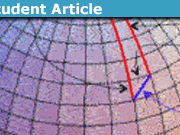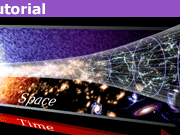Where Did the Big Bang Happen?
According to standard cosmological models, which are based on general relativity and are found to agree well with observations, time and space did not exist before the Big Bang — or even at the time of the Big Bang, which is a point where the theory breaks down because various quantities (such as temperature and spacetime curvature) are infinite. Therefore these models do not describe the Big Bang as an explosion that happened at a particular point in a preexisting landscape of time and space.
These are only statements about a particular kind of model. The model incorporates various assumptions, and as we get closer and closer to the Big Bang, these assumptions become more and more uncertain. For example, it is possible that under conditions of very high density and temperature, the matter has exotic behavior that causes gravity to become repulsive. If this happens, then it’s possible that the Big Bang was not a bang but a bounce, and then time could be extended farther back into the past.
But even if time existed before the Big Bang, there is still another reason not to imagine the Big Bang as happening at one point in a preexisting space. Observations of the universe show a nearly complete lack of structure on very large scales, and the cosmic microwave background is also extremely uniform (with fractional temperature differences on the order of 10-5). For this reason, realistic cosmological models must be almost exactly homogeneous, meaning that no point in space has properties that differ very much from those of any other point. Therefore the best evidence is that the Big Bang happened uniformly, everywhere at once.
Since realistic cosmological models are homogeneous, every point in space has the same properties as every other point, and therefore the models don’t have a center. We can visualize this using the metaphor in which galaxies are dots on a balloon being blown up. No point on the balloon is the center of expansion. If you want to pick out a center, you have to pick a point in the air, not on the surface of the balloon. But in the balloon analogy, the third dimension is just a visualization aid. Only points on the balloon’s two-dimensional surface represent actual points in space.
The following forum members have contributed to this FAQ:
bcrowell
George Jones
jim mcnamara
marcus
PAllen
tiny-tim
vela
This article was authored by several Physics Forums members with PhDs in physics or mathematics.








Since the responses in this comments thread have been mostly personal theories, speculation, or off-topic (all of which have been removed) it is the consensus of the mentors that the thread be locked.
Thread locked for moderation.
The Universe is massively non-linear and most of the equations of mathematical physics are likewise non-linear. I think we have agreement on that. What is a defining characteristic of non-linear dynamics? Critical-point jump-discontinuities. One obtains an intuitive understanding of this by studying non-linear differential equations like for example this one:[tex]frac{dz}{dt}=-z^3+bz+c[/tex]This is the cubic differential equation and it exhibits a cusp catastrophe. The system defined by this equation exhibits a jump discontinuity as it passes a critical point in its dynamics. Often, the underlying phenomenon described by a non-linear equation undergoes a qualitative change, like water suddenly changing to ice at the critical point of freezing. Consider the concept of swimming. Swimming looses meaning as water trajects across this critical point. Is it really such a stretch of logic to suggest the same may be true about the origins of the Universe? That is, on the other side of the critical point of the big-bang, perhaps not only time and space are no longer applicable but the physics we understand today as well. If that is possible, then we may need to adjust our thinking about the pre-existence and not try to explain it in terms of the physics we see on our side of the critical point. Then all the questions we commonly see in this forum about where, when, what and even why about the Big Bang could in my opinion be better approached from a qualitatively different perspective than how we understand the Universe today. And therefore, from this perspective, one can easily answer "where did the Big Bang happen?" That question necessarily requires a trajection across a critical point (the Big Bang) and therefore our concepts of time, space, distance, matter, energy, and perhaps even our laws of physics may not be applicable (like swimming in ice above) and thus the question, until perhaps we have a fundamental shift in our understanding of Nature, may not now be answered adequately.
"time and space did not exist before the Big Bang"Reference https://www.physicsforums.com/insights/big-bang-happen/(technically speaking, since "before" and "after" denote points "in time", according to standard models any reference to "before" the Big Bang is meaningless)
[QUOTE="Bandersnatch, post: 5499879, member: 399360"]Please provide evidence for this claim.”Yes, I should have, but I failed to find my source while online. I will look for it and post it. I think I read it a long time ago in a magazine article. Thank you for asking.
[QUOTE="tgarcia39, post: 5499874, member: 581888"]so-called "Great Void" in which it is said the singularity existed when it first began to expand”Please provide evidence for this claim.
Essentially, I agree that time did not exist before the BB, because I contend that time is a property of matter and passes at rates inversely proportional to the speed of discrete matter. Matter did not exist initially at the BB, but was created only later after massive particles formed. I think that only because matter is E=mc[SUP]2[/SUP], or, matter is comprised of a mass having energy and motion. As for the idea that space came out of the singularity, I propose that is not a possiblity on the basis that the so-called "Great Void" in which it is said the singularity existed when it first began to expand, is an unfalsifiable premise (to say the least) and as such, it must invalidate any further premises and conclusions stemming from the proposed concept. The theory, therefore, breaks down at its very beginning. While "…the model incorporates various assumptions…." we must understand assumptions are mere guesses, thus, any conclusion based on non-factual premises must never be considered as anything other than what they are – unconfirmed claims. Such claims cannot be defended in debate; they can only become personal beliefs. Finally, the balloon analogy, e.g., is an unrealistic model because the U. requires it to be explained as a 4-dimensional place.
Thanks for the post! This is an automated courtesy bump. Sorry you aren't generating responses at the moment. Do you have any further information, come to any new conclusions or is it possible to reword the post?
[QUOTE="Stavros Kiri, post: 5498674, member: 593167"]So there are more than one standard cosmological models (and based on, but not identified with, GR …).”There is only one overarching standard model of cosmology. It's known as the Lambda-CDM model and uses GR (I don't know what "identified with" even means). Let me be clear. The standard model is the de-facto model all observations are first fit into. Every effort is made to fit observations into this model before attempting to posit other explanations outside of the model. Put simply, it is the best description of the universe at large scales and provides the most accurate predictions out of any other model at this time.What you don't seem to understand is that all of those "other" models are NOT "accepted" models. Only a comparatively handful of people are working with them and they are only doing so in an attempt to explain things which do not fit within the standard model at this time. Some of them may be based on GR but they are not "standard models" by any means and I would treat them all with a grain of salt given their extremely speculative and generally mutually incompatible natures (along with the near complete and utter lack of observations supporting the vast majority of them over any other model).[QUOTE="Stavros Kiri, post: 5498674, member: 593167"]In any case, so that you know, our dissagreement is perfectly within the topic, and in fact an important key and tricky issue. My opinion is that we are both right.”No, the few claims you've made about mainstream science have simply been wrong. The standard cosmological model does not use 4 spatial dimensions and GR, as it is currently used in mainstream physics, does not use "extrinsic" curvature as you implied in post #12. And despite my warnings and your claim to the contrary, you keep going back to speculative theories that have nothing to do with the insights article, as if these models and theories had equal weight to the standard model. They do not. Not even close. Everything talked about in this insights article is covered by the standard model of cosmology.Thread locked.
[QUOTE="Drakkith, post: 5498664, member: 272035"]Stavros, I don't care what other theories out there say or how they are formulated. I'm talking about the standard model of cosmology, which uses GR. As I already said, if you want to talk about other possibilities then do it in another thread.”I already said that I don't want to talk about other theories, other than what I already said. We are just dissagreeing on a key but tricky issue here. I think the answer is given by the article itself, that you are legitimetly defending:"According to standard cosmological models, which are based on general relativity and are found to agree well with observations, time and space did not exist before the Big Bang — or even at the time of the Big Bang, which is a point where the theory breaks down because …"Reference https://www.physicsforums.com/insights/big-bang-happen/So there are more than one standard cosmological models (and based on, but not identified with, GR …). Some of them are assuming 3+1 spatial … (including Einstein himself in his latest cosmologies) and still can talk about big bang. You can also do the search for cosmological models that I suggested. But the essence may not change much (intrinsic … vs extrinsic …).In any case, so that you know, our dissagreement is perfectly within the topic, and in fact an important key and tricky issue. My opinion is that we are both right.But I do not plan to pursue this any further, unless you motivate me.
Stavros, I don't care what other theories out there say or how they are formulated. I'm talking about the standard model of cosmology, which uses GR. As I already said, if you want to talk about other possibilities then do it in another thread.
[QUOTE="Drakkith, post: 5498646, member: 272035"]The Standard Model of Cosmology is built using the framework of GR and as such has 3 spatial dimensions.It's not a suggestion. It is literally how GR is formulated (and the math GR itself is built on). Whether or not Einstein considered an extra spatial dimension a possibility is irrelevant. Neither GR nor Cosmology incorporate an extra dimension.”I agree about GR and intrinsic curvature. But to put it simply there are many cosmological theories and models [most of them based on GR]. GR itself has limmited range (without cosmological assumptions). GR cosmology is a different thing (e.g. + the step of the introduction of the cosmological constant Λ by Einstein himself) and there are many versions and models*, also playing with the number of dimensions.Perhaps you mean observational cosmology. Things differ a lot there.And a different issue and concern: the big bang theory is part of the standard model and it is neither GR nor just cosmology. It is actually particle physics and/or combinations.*you may look under "cosmological models-theories"
[QUOTE="Stavros Kiri, post: 5498634, member: 593167"]I didn't say GR. I said GR cosmology etc.”The Standard Model of Cosmology is built using the framework of GR and as such has 3 spatial dimensions.[QUOTE="Stavros Kiri, post: 5498634, member: 593167"]When Einstein tried to apply GR for the universe as a whole he envisioned that extra dimension as a possibility, although your suggestion also stands.”It's not a suggestion. It is literally how GR is formulated (and the math GR itself is built on). Whether or not Einstein considered an extra spatial dimension a possibility is irrelevant. Neither GR nor Cosmology incorporate an extra dimension.
[QUOTE="Drakkith, post: 5498632, member: 272035"]That's not correct. GR does not involve 4 spatial dimensions. The curvature of GR is intrinsic curvature, not extrinsic curvature, and does not require a fourth spatial dimension.”I didn't say GR. I said GR cosmology etc. . When Einstein tried to apply GR for the universe as a whole he envisioned that extra dimension as a possibility, although your suggestion also stands. Both stages exist in the cosmological research.
[QUOTE="Stavros Kiri, post: 5498626, member: 593167"]"3+1 spatial …" means 4 spatial (e.g. for GR cosmology and/or Einstein and Kaluza-Klein theories), thus 4+1 = 5 total (with time) …I think you missunderstood.”[QUOTE="Stavros Kiri, post: 5498628, member: 593167"]The 4 spatial is already tacit in general relativistic cosmology and big bang. That's how curvature is understood in our universe. For more dims (10, 11 or 23 …) I agree with you it is indeed off topic.”That's not correct. GR does not involve 4 spatial dimensions. The curvature of GR is intrinsic curvature, not extrinsic curvature, and does not require a fourth spatial dimension.
The 4 spatial is already tacit in general relativistic cosmology and big bang. That's how curvature is understood in our universe. For more dims (10, 11 or 23 …) I agree with you it is indeed off topic.
[QUOTE="Drakkith, post: 5498623, member: 272035"]I meant extra spatial dimensions. Time is always a necessity, so it's not usually stated unless it really needs to be.”"3+1 spatial …" means 4 spatial (e.g. for GR cosmology and/or Einstein and Kaluza-Klein theories), thus 4+1 = 5 total (with time) …I think you missunderstood.
[QUOTE="Stavros Kiri, post: 5498622, member: 593167"]What about 3+1 spatial dimensions?”I meant extra spatial dimensions. Time is always a necessity, so it's not usually stated unless it really needs to be.
[QUOTE="Drakkith, post: 5498621, member: 272035"]Perhaps. In any case, this article is strictly about the big bang theory in its current state, which says nothing about extra dimensions, so I think further discussion on this topic belongs in another thread.”What about 3+1 spatial dimensions? That's standard. See also my previous editted comment. But I also agree that there are problems, plus I pretty much said all I had to say.
[QUOTE="Stavros Kiri, post: 5498576, member: 593167"]I think it is consistent, and in essence we agree.”Perhaps. In any case, this article is strictly about the big bang theory in its current state, which says nothing about extra dimensions, so I think further discussion on this topic belongs in another thread.
But these views assume hyperuniverse (or multiverse) …
[QUOTE="Drakkith, post: 5498584, member: 272035"]I'm not so sure. The balloon analogy is necessarily flawed. It has a finite surface and the surface collapses back towards a single point in 3D space. If the universe is not structured in this manner, for instance if it is infinite in size and doesn't curve back on itself, then I don't think your view works.”You do have a point, but there is a lot of mathematical processing details left out. See also my previous fully editted comment.
[QUOTE="Stavros Kiri, post: 5498576, member: 593167"]I think the center of the 3-dim sphere in the analogy is the key and the answer.”I'm not so sure. The balloon analogy is necessarily flawed. It has a finite surface and the surface collapses back towards a single point in 3D space. If the universe is not structured in this manner, for instance if it is infinite in size and doesn't curve back on itself, then I don't think your view works.
[QUOTE="Drakkith, post: 5498575, member: 272035"]I don't think that's correct. The big bang happened everywhere in our three-dimensional universe. If we assume there's a higher dimension then that would mean that the big bang still occurred at an infinite number of points. If we imagine a 2D universe embedded in three dimensions, a big bang taking place only within those two dimensions would still occur in an infinite number of points in the 3D space. An infinitely large 2D plane is still infinitely large when embedded in three dimensions.”I think the center of the 3-dim sphere in the analogy is the key and the answer. And that's "one point", but not in our space …
[QUOTE="Stavros Kiri, post: 5498543, member: 593167"]Unless we assume hyperspace … . Then everything is answered consistently. The big bang happened in "one point in hyperspace"”I don't think that's correct. The big bang happened everywhere in our three-dimensional universe. If we assume there's a higher dimension then that would mean that the big bang still occurred at an infinite number of points. If we imagine a 2D universe embedded in three dimensions, a big bang taking place only within those two dimensions would still occur in an infinite number of points in the 3D space. An infinitely large 2D plane is still infinitely large when embedded in three dimensions.
[QUOTE="Multiple_Authors, post: 5495537, member: 571894"]multiple_authors submitted a new PF Insights postWhere Did the Big Bang Happen? Continue reading the Original PF Insights Post.“"time and space did not exist before the Big Bang — or even at the time of the Big BangReference https://www.physicsforums.com/insights/big-bang-happen/"+
Continue reading the Original PF Insights Post.“"time and space did not exist before the Big Bang — or even at the time of the Big BangReference https://www.physicsforums.com/insights/big-bang-happen/"+
To me the lowest common denominator in the Universe is Change. It is absolute, continuous and seamless. This change, at the universal level, does not happen in Planck Time, but instantaneously. The Universe has never not changed. The medium of this Change is Gravity, and prior to the Big Bang, Gravity was absolute. For all practical purposes it was “opaque”, absolutely dense and linearly focused on a single point. This was the Universe in its "initial state". Time, Matter, Energy and Space did not exist…just Absolute Gravity and the “Prime Directive” of Change. The Universe literally popped into existence out of “nowhere” and in “no time” because it HAD to…given the Universal Law of Change and the Universal Medium of Gravity. The mechanics of this change was the collapse of the Gravitational Focal Point, in which the former linearly focused Gravitational lines wound around the focal point in 3D rotation until the “core” reached a "critical density" and resulted in the Big Bang. With the creation of Matter, Energy and consequently Space and Time, Gravity assumed a new non-linear configuration in the form of physical Matter (“twisted” Gravity) and another expression in the form of energy (Gravity in motion). The vestiges of the Absolute Gravity are still evidenced in the Universe today, although Gravity may be regarded as a by-product of Universe, as opposed to an original fundamental building block. As the saying goes, “As soon as we are born, we begin dying”, such is the nature of the Universe. The Universe will eventually decay. Black Holes may be a process by which Matter and Energy are recycled into Free Gravity, which may account for Dark Matter. Dark Energy may be a Gravitational remnant of the Big Bang that is not a repulsive force but an attractive force at the Universal Horizon. The Universe may seem quite complex both in an infinite and an infinitesimal sense, but its origin must have been fundamentally neat and simple. It had no “beginning” and it will have no “end”…just a change in state (definition). It is an infinite repetition of finite cycles and fundamentally deterministic. After this being said, it would be impossible for any “origins” science to be actually proven. It can only remain in the realm of philosophy and speculation.
https://sickphysics.wordpress.com/2015/05/12/contradiction-of-big-bang-theory-and-circular-motion/ Have a look. This will not tell you where this happened, but probably raise a few more question.